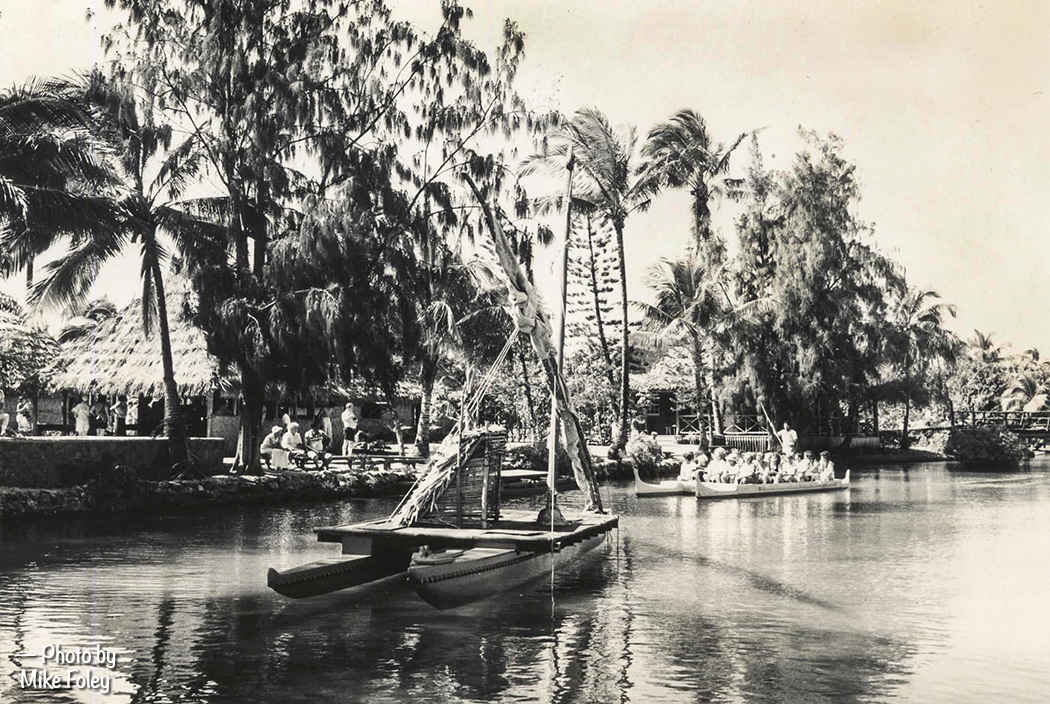
— Memories and photo by Mike Foley

Not long after I came back to work (full-time) at the Polynesian Cultural Center in public relations in the early 1980s, after living in Honolulu for about five years and working in journalism and PR, I played a small role with the Tongan kalia canoe in the picture.
Distinctive canoes at the Center: Now, the Cultural Center certainly has some distinctive canoes, at least one of which — the 40-man waka taua from New Zealand in the Maori Village — has been there since the beginning. There’s also a “fleet” of working tour canoes as well as a pageant performance canoes.
But to give them proper respect, BYU–Hawaii’s Iosepa, a traditional 60-foot wa’a kaulua (twin-hulled) sailing canoe is probably the most prestigious canoe at the Center today. Carved by Tui’one Pulotu and Kawika Eskaran throughout most of 2001, with lots of community, volunteer and organizational help, it was launched on November 3 that year at Hukilau Beach in Laie, with several thousand people in attendance. The Iosepa has been permanently berthed in a spectacular hālau wa’a (canoe house) in the Center’s Hawaiian Village since July 2008.
The historic Fijian camakau, another traditional sailing canoe, started its journey in 1985 as a huge tree on the small island of Kabara in Fiji’s Lau Islands archipelago (between Fiji and Tonga), but now lies in its own canoe house in the Fijian Village. Then-Prime Minister (and later President of Fiji) Ratu Sir Kamisese Mara, who was also the Tui Nayau or paramount chief in all the Lau Islands, and his wife came to the Cultural Center on March 24, 1986, to hand over the canoe.
There have been others, but another canoe worth noting is the beautiful Samoan va’aalo on display in the Samoan Village which, I think, is about 25-feet long. Traditionally, Samoans created va’aalo, a type of outrigger canoe paddled by two men (one at each end), with a third in the middle, fishing for large tuna-like bonito.
What makes the Center’s va’aalo extra special? In the mid-1980s, the Center acquired a large koa-wood log, which were then (and now) difficult to obtain; and Tapusoa Tumu Purcell, one of the Center’s skilled carvers, shaped it into the va’aalo on site.
The scale-model Tongan kalia, while patterned after ancient kalia-style canoes, is a modern scale model based on a double-hulled design where the smaller hull acts as an outrigger. If you look carefully, you can see the hull on the left side in the picture is smaller.
Unfortunately, the Center’s kalia had only a relatively short life in Laie. Its story began with noted Hawaiian artist Herb Kane, who was involved in the mid-1970s with creating the well-known Hōkūle’a Hawaiian sailing canoe, currently circumnavigating the Pacific Rim. Kane also painted a series of colorful, popular Hawaiian and Polynesian pictures based on history and legend.
One day in the early 1980s, then-Center General Manager William H. “Bill” Cravens and I were talking about some of Kane’s artistic images when he said he wished the Center had a canoe like that. I responded that I interviewed Kane a few years earlier as a journalist, and was sure I could put them together. Long story short, Cravens and Kane talked, and not long after the Center purchased a set of marine-architectural plans from him for a whole series of “historic” Polynesian canoes.
Enter Tui’one Pulotu: The Center asked Pulotu to build one of each. He started with the Tongan kalia by first creating fiberglass molds for the hulls, then adding the deck, mast, and other fixtures. It turned out beautifully, and I’m vaguely remembering (or perhaps thinking) it was originally painted reddish.
Those of you who have actually been IN the Center’s lagoon know it’s not very deep; so unfortunately, it wasn’t until after the kalia was nearly done several problems became apparent:
Someone noticed the canoe hulls were too large, and would “run aground” in some places in the lagoon, AND the canoe’s “deep-draught” hulls also meant the kalia could not fit under several of the Center bridges in those days. (Remember the canoe boys’ joke: “A LOW BRIDGE”?)
The last chapter: I’ve forgotten how long the kalia stayed there, but the Center left it floating (and sometimes tied to the shore) in the lagoon between the Samoan Village and the original Tongan Village (which was eventually moved to its present location when what is now known as the Hawaiian Journey Theater was built in the late 1980s).
In any case, I used to love including it in PR photos, because no other visitor attraction I knew of had scenes like that. Notice, the Mission Settlement appears in the photo background; it was opened in 1984.
However long the kalia stayed out there, after a while a Center maintenance crew hauled it out of the lagoon and parked it in the mauka maintenance lot, where it eventually deteriorated.
The Center did not build any other Herb Kane-designed canoes, and the last time I checked, nobody knew what happened to the set of designs . . . thus ending this chapter of Polynesian Cultural Center history.


